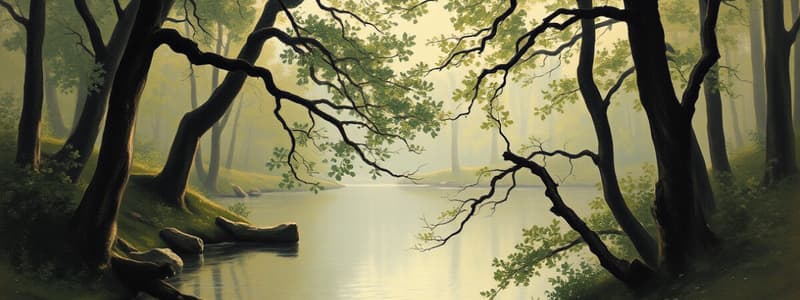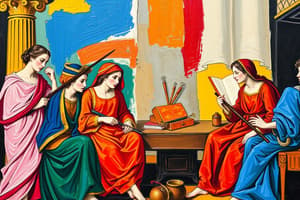Podcast
Questions and Answers
What are the characteristics of Classicism?
What are the characteristics of Classicism?
- 1750-1820 (18th-19th centuries)
- Melody with emotional restraint and duality
- Dynamics characterized by long crescendos
- All of the above (correct)
What does 'form' refer to in classical music?
What does 'form' refer to in classical music?
Organization and design of a composition or movement
What is a cadenza?
What is a cadenza?
An extended cadence played by a soloist, usually improvised
What is a solo concerto?
What is a solo concerto?
What characterizes a string quartet?
What characterizes a string quartet?
What is sonata-allegro?
What is sonata-allegro?
What is a rondo?
What is a rondo?
What does 'coda' mean in music?
What does 'coda' mean in music?
What are the types of comic opera mentioned?
What are the types of comic opera mentioned?
What is a pants or trouser role in opera?
What is a pants or trouser role in opera?
Flashcards are hidden until you start studying
Study Notes
Classicism Characteristics
- Time period: 1750-1820, marking the transition from Baroque to Classical music.
- Instrumental music flourished, leading to fewer vocal pieces created during this era.
- Emphasis on beauty found in order, symmetry, balance, and control.
- Melody exhibits emotional restraint, characterized by a question/answer phrase structure and contrasting sections.
- Texture predominantly features homophony, with prominent melodies and less focus on bass.
- Dynamics display subtleness yet are impressive, often employing longer crescendos.
- Timbre: Greater importance placed on instrumental music, focusing on orchestral sounds; the piano emerged as the primary keyboard instrument.
Form
- Represents the organization and design of a composition or individual movement.
- In the absence of text, greater significance is given to musical form, paralleling literary structures with elements like repetition and contrast.
Cadenza
- An extended cadence performed by a soloist, typically improvised.
- Features an orchestra crescendoing before dropping out, concluding with a trill from the soloist, which prompts the orchestra's return.
Solo Concerto
- Emerged following the decline of the concert grosso, which featured large orchestras typical of the Baroque period.
- Composers began writing solo performances, integrating instruments within orchestral works.
String Quartet
- A prominent form of chamber music during the Classical era, typically comprising two violins, a viola, and a cello.
Sonata-Allegro
- A structural form used in first movements of symphonies, concertos, sonatas, or string quartets, characterized by its ABA structure.
Rondo
- A musical form denoted by ABACA, serving as the last movement in compositions, known for its lively and cheerful nature.
Coda
- Definition: Translates to "tail," referring to the concluding section of a musical piece.
Comic Opera
- Known as opera buffa in Italian, singspiele in German, and opera comique in French.
- This genre gained popularity, featuring comedic elements inserted between acts of serious operas.
Pants or Trouser Role
- A role in opera typically written for a female singer, portraying a young boy to express youth and innocence.
Studying That Suits You
Use AI to generate personalized quizzes and flashcards to suit your learning preferences.




